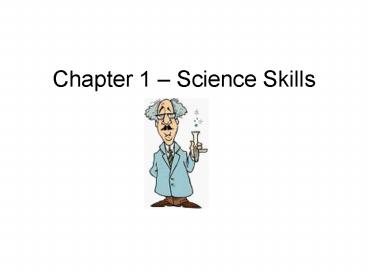Chapter 1 Science Skills - PowerPoint PPT Presentation
1 / 31
Title:
Chapter 1 Science Skills
Description:
Scientific Method = organized plan for gathering, organizing, and ... Scientific Notation makes very large or very small #'s easer to work with by ... – PowerPoint PPT presentation
Number of Views:248
Avg rating:3.0/5.0
Title: Chapter 1 Science Skills
1
Chapter 1 Science Skills
2
1.1 What is science?
- Science a system of knowledge and the methods
you use to find that knowledge - Curiosity is the basis of science.
- Science and technology are interdependent.
3
Branches of Science
4
Big Ideas of Physical Science
- Space and Time
- Matter and Change
- Forces and Motion
- Energy
5
1.2 Using a Scientific Approach
- Scientific Method organized plan for gathering,
organizing, and communicating information
6
(No Transcript)
7
A Scientific Method
- Making Observations
- Observation info that you obtain through your
senses - Inference conclusions drawn based on
observations - Develop a question or problem
- Form a Hypothesis
- Hypothesis proposed answer to your question
8
- Testing a hypothesis
- Manipulated (independent) variable changed
intentionally to test hypothesis - Responding (dependent) variable changes in
response to manipulated variable - Controlled variable factors that are kept
constant to test hypothesis - Control Group a setup run without manipulated
variable
9
- Drawing Conclusions determining whether or not
data collected supports hypothesis - Developing a Theory
- Scientific Theory well-tested explanation for a
set of observations or experimental results - Theories are never proved
- Theories may be revised or replaced
10
Scientific Laws
- Scientific law a statement that summarizes a
pattern found in nature - A law DOES NOT attempt to explain an observed
pattern in nature
11
Scientific Models
- Scientific Models make it easier to understand
things that might be too difficult to observe
directly. - Ex. Atomic models, models of the solar system,
cell models, etc.
12
(No Transcript)
13
Safety
- Most important rule Follow your teachers
instructions and the textbook directions exactly.
When in doubt, ASK!!! - See handout of safety rules and procedures.
14
1.3 Measurement
- Scientific Notation makes very large or very
small s easer to work with by expressing a
value as a number from 1-10 times a power of 10. - Ex. 300,000,000,000 3x1011
- .00000006 6x10-8
15
SI Units of Measurement (Metric)
- Length straight line dist. between two pts. -
measured in meters (m) - Mass amt. of matter in an object measured in
grams (g) - Volume amt. of space occupied by an object
measured in liters (L)
16
(No Transcript)
17
Limits of Measurement
- Precision a gauge of how exact a measurement is
- Accuracy closeness of a measurement to the
actual value
18
(No Transcript)
19
Significant Figures
- Sig Figs are the digits in a number that carry
meaning contributing to its precision. - A calculation can only be as precise as its
LEAST precise measurement.
20
Sig Fig Rules
- All numbers that are not zeros are always
significant. - Any zero between two sig figs is significant.
- Trailing zeros are only significant in the
decimal portion.
21
How many sig figs?
- 50.5
- 26.25
- 10,100
- 500
- 650
- .050
- 1.0250
22
1.4 Presenting Scientific Data
- Scientists organize data using data tables and
graphs.
23
Data Tables
- Relate the manipulated and responding variables
24
(No Transcript)
25
Line Graphs
- Show changes in related variables
- Manipulated (Independent) variable is plotted on
the x-axis. - Responding (Dependent) variable is plotted on the
y-axis.
26
(No Transcript)
27
(No Transcript)
28
(No Transcript)
29
Bar Graphs
- Often used to compare a set of measurements,
amounts, or changes.
30
(No Transcript)
31
Circle Graphs
- Show how part relates to the whole
- Entire circle represents 100, and slices
represent percentages that make up the 100































